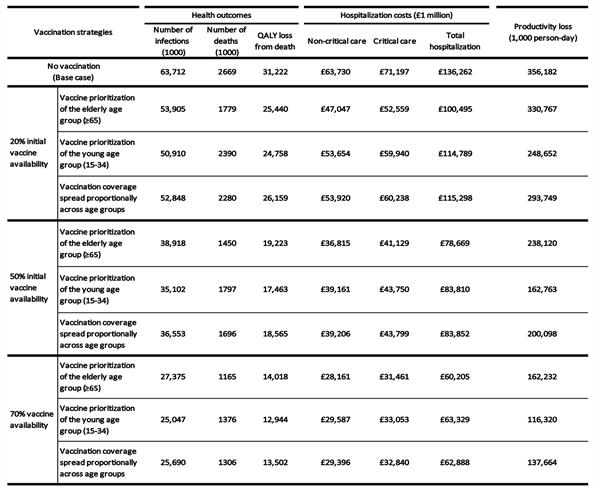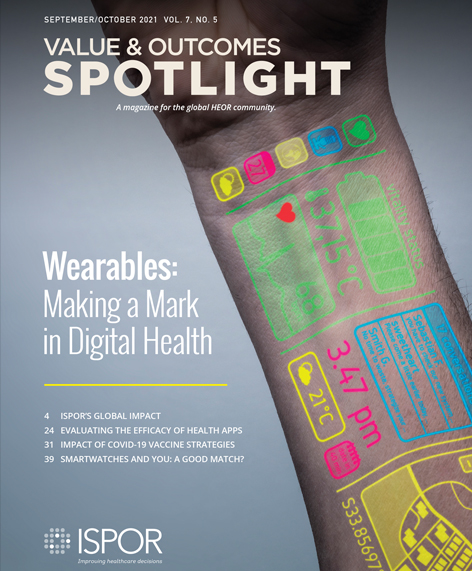Predicting the Impact of Vaccination Strategies in the COVID-19 Pandemic Using a Susceptible-Exposed-Infectious-Removed Model
Yunni Yi, PhD, Alex Hirst, PGDip, Stefano Lucherini, MSc, Adelphi Values, Cheshire, England, UK; Wei Song, MSc, Adelphi Values, Cheshire, England, UK; Centre for Health Economics, The University of York, York, England, UK
Background
The COVID-19 pandemic has resulted in 180 million infections and 3.9 million deaths worldwide and both figures are still rising.1 Variants of the virus are threatening to produce new waves of infections with no sign of extinction at the present time.2 The consequences of the pandemic, both direct and indirect, on healthcare systems, social life, and economic activities are unprecedented.3
Despite policy measures such as social distancing or lockdowns and improvement in diagnosis and treatment of COVID-19, it has become apparent that vaccines provide the best protection against the spread of the disease.4 A range of vaccines have been approved already and are being administered within several countries. However, supply of safe and effective vaccines will be limited in the foreseeable future by production and distribution capacities. Therefore, a vaccination strategy must be based on the prioritization of specific population subgroups to minimize the disease burden.
Our Approach
We developed a susceptible-exposed-infectious-removed (SEIR) model in R Project® to predict the impact of different COVID-19 vaccination strategies on the number of infections, mortality, healthcare burden, and productivity loss in the United Kingdom.5
Given the uncertainty in vaccine supply, 3 scenarios were explored where 20%, 50%, and 70% of the United Kingdom population were vaccinated. For each of the 3 scenarios, 3 population-wide vaccination strategies with different age group priorities (0-14, 15-34, 35-64, ≥65) were modeled in addition to no vaccination. For each vaccination strategy the total number of infections, COVID-19 related deaths, quality-adjusted life years (QALYs) loss, hospitalization costs, and productivity loss were estimated (Table).
Table. Vaccination strategies and predicted outcomes.

Age-group specific proportions of asymptomatic infections, probability of severe symptoms, and death rates were identified from published literature. Key parameters defining individuals moving through the model include rate of infection, rate of removal, and basic reproduction number. QALY losses were estimated through the standard life table approach with quality adjustment6 and time preference discounting. Hospitalization costs included critical and noncritical care for symptomatic patients based on different inputs on service utilization and length of stay. National Health Service reference costs were used to calculate the hospital costs per day.7 Productivity loss measured as working days lost was calculated for the working-age population based on weighting the number of days spent in hospital care and the number of days being mildly symptomatic due to an active COVID-19 infection.
Results
As shown in the Table, under each vaccine supply scenario, the model predicted that vaccinating the 15–34 age group first would lead to the lowest number of infections as well as the lowest loss of QALYs, while vaccinating the 65+ age group first would result in the lowest number of deaths. When considering the impact on healthcare resource use, vaccinating the 65+ age group first resulted in the lowest costs in both critical and noncritical care, as well as total hospitalization costs, compared to other vaccination strategies. The model further showed that vaccinating the 15–34 age group first was the most effective strategy for minimizing productivity loss, followed by vaccinating all age groups proportionally.
All vaccination strategies performed better over no vaccination for all the outcomes measured. For each outcome, the patterns observed with the order of priority for different population subgroups did not change when the vaccine supply increased from covering 20% to 50% and 70% of the population, respectively. All outcomes improved with greater vaccination coverage, although the differences in each outcome across the vaccination strategies for vaccinating different age groups first were smaller, suggesting prioritizing age groups is more important when supply or coverage is low.
The issue of vaccination is a complex one, and the limitations of this research must also be acknowledged so that the evidence can be applied appropriately to decision making.
Implications for the Future
COVID-19 has severely impacted all sectors of society across the globe. Vaccinations play a vital role in curbing the effects of the pandemic, but the availability of safe and effective vaccines at any one point in time is limited. National, regional, and global decision makers need to establish strategies on procuring, paying for, distributing, and using new vaccines against COVID-19.8,9 Giving priority to the appropriate subpopulation at each stage is essential to maximize the health, social, and economic benefits of immunization.
Compartmental models such as SEIR can be useful to support informed decisions on various vaccine strategies for COVID-19.9 Parsimonious compartmental models have been widely applied in the field of infectious disease, as they require a small number of predictor variables to generate significant explanatory power. This is advantageous especially during the earlier phases of the pandemic, where decisions need to be made with constraints on available data. The simplicity and easy maintenance of the SEIR model means that it is an ideal tool for prompt analysis and continuous update of the potential effects of interventions. This study explored its application in health economic evaluations of COVID-19 vaccination strategies in the United Kingdom.
Our findings confirmed that all vaccination strategies produce desirable reductions in numbers of infections, mortality, QALY loss, and productivity loss compared to no vaccination. Furthermore, while the optimal vaccination strategy will differ depending on what objectives are desirable, prioritization of specific population subgroups is shown to be key for achieving these outcomes. In contrast, a strategy where all age groups are vaccinated simultaneously in a proportional fashion leads to the heaviest burden on the health system as well as the highest costs. These findings are consistent with published studies in the United Kingdom,13 and in line with the advice provided by the UK Joint Committee on Vaccination and Immunization,14 which suggests prioritizing the direct prevention of mortality, as well as supporting the National Health Service and social care systems. These findings may be useful for countries that are still developing the vaccination programs for COVID-19.
The issue of vaccination is a complex one, and the limitations of this research must also be acknowledged so that the evidence can be applied appropriately to decision making. The model focused only on vaccine distribution across different age groups and no other health conditions were incorporated. It also did not consider different types of vaccines and nonpharmacological interventions, nor did it consider virus mutations that are resistant to current vaccines and the possible implications for long-term immunity achieved with vaccination. The model assumed immediate immunity following vaccination without considering different vaccine timing and lengthy booster shot cycles required by different vaccines. Revised models incorporating more relevant factors are an area for further research.
When ranking the strategies, the outcome domains for each strategy were considered separately. However, in reality, vaccination strategies need to account for multiple outcomes simultaneously. This can be achieved through cost-effectiveness analysis to encompass wider costs and benefits within society or multicriteria decision analysis where several relevant criteria can be considered and weighted explicitly, leading to more informed decisions with a broader perspective of the issue.
Closing Thoughts
In conclusion, vaccines are important healthcare interventions for fighting COVID-19. A SEIR-based model requires little data to predict clinical and economic outcomes of alternative vaccination strategies and is easily adaptable in fast moving situations. SEIR can be a useful tool to inform decisions on vaccination strategies including the selection of different types of vaccines for different population. However, policy makers are required to establish clear goals and objectives with predefined criteria for measurement before the optimal strategy can be identified. Supported with more accurate data, findings from this and similar modeling studies can help to inform government policies regarding the procurement and delivery of vaccines to ensure efficient use of the limited resources available. Although this study focused primarily on the United Kingdom, the results serve as a framework that can be applied to any country when devising COVID-19 vaccination strategies as well as other forms of interventions for tackling future pandemics.
References:
1. World Health Organization 2021. WHO Coronavirus (COVID-19) Dashboard. https://covid19.who.int Accessed June 25, 2021.
2. British Heart Foundation. Heart Matters Magazine. COVID Variants: Get the Latest on Delta and Other Coronavirus Variants. https://www.bhf.org.uk/informationsupport/heart-matters-magazine/news/coronavirus-and-your-health/covid-variant. Published 2021. Accessed June 17, 2021.
3. The United Nations. United Nations Comprehensive Response to COVID-19: Saving Lives, Protecting Societies, Recovering Better. https://www.un.org/sites/un2.un.org/files/un-comprehensive-response-to-covid-19.pdf. Published September 2020. Accessed June 17, 2021.
4. The Johns Hopkins Bloomberg School of Public Health. Why COVID-19 Vaccines Offer Better Protection Than Infection. https://www.jhsph.edu/covid-19/articles/why-covid-19-vaccines-offer-better-protection-than-infection.html. Published May 28, 2021. Accessed June 17, 2021.
5. Song W, Yi Y. Predicting the impact of vaccination strategies in the COVID-19 pandemic using a susceptible-exposed-infectious-removed (SEIR) model. PIN20, 2021-05, Virtual ISPOR May 2021.
6. Briggs AH, Goldstein DA, Kirwin E, et al. Estimating (quality-adjusted) life-year losses associated with deaths: with application to COVID-19. Health Econ. 2021;30(3):699-707.
7. Curtis LA, Burns A. Unit Costs of Health and Social Care 2012. Personal Social Services Research Unit, University of Kent. ISBN 978-1-911353-10-2. doi:10.22024/UniKent/01.02.79286.
8. Office of Health Economics. OHE Consulting Report. Berdud M, Jofre-Bonet M, Rodes-Sanchez M, Towse A. Key Factors on How to Procure, Pay For, Distribute, and Use Vaccines for COVID-19: A European Perspective. https://www.ohe.org/publications/key-factors-how-procure-pay-distribute-and-use-vaccines-covid-19-european-perspective. Published May 2021. Accessed June 17, 2021.
9. Roope LSJ, Buckell J, Becker F, et al. How should a safe and effective COVID‑19 vaccine be allocated? Health economists need to be ready to take the baton. Pharmacoecon Open. 2020;4(4):557-561. https://doi.org/10.1007/s41669-020-00228-5.
10. Moore S, Hill E, Dyson L, et al. Modelling Optimal Vaccination Strategy for SARS-CoV-2 in the UK. PLoS Comput Biol. 2021;17(5):e1008849. doi:https://doi.org/10.1101/2020.09.22.20194183
11. Gov.UK. Department of Health and Social Care. Joint Committee on Vaccination and Immunisation: Advice on Priority Groups for COVID-19 Vaccination. https://www.gov.uk/government/publications/priority-groups-for-coronavirus-covid-19-vaccination-advice-from-the-jcvi-30-december-2020/joint-committee-on-vaccination-and-immunisation-advice-on-priority-groups-for-covid-19-vaccination-30-december-2020. Updated January 6, 2021. Accessed June 17, 2021.

